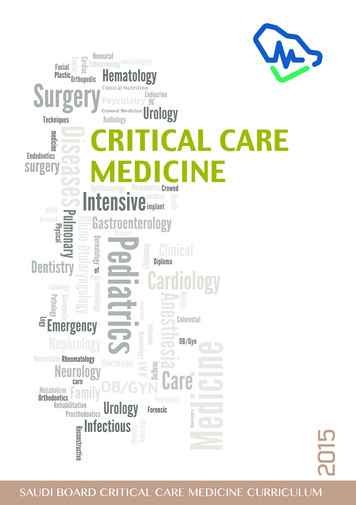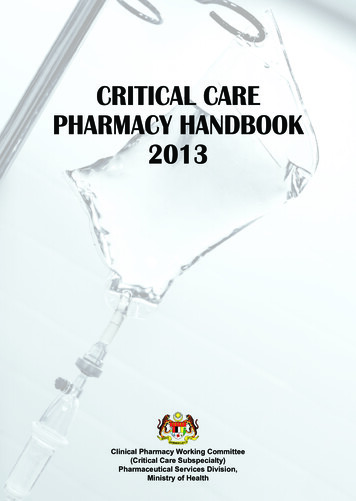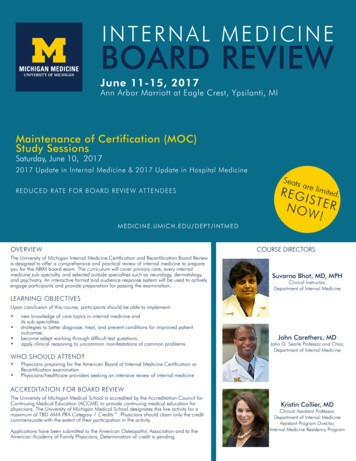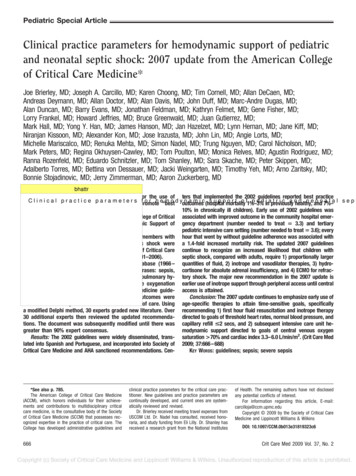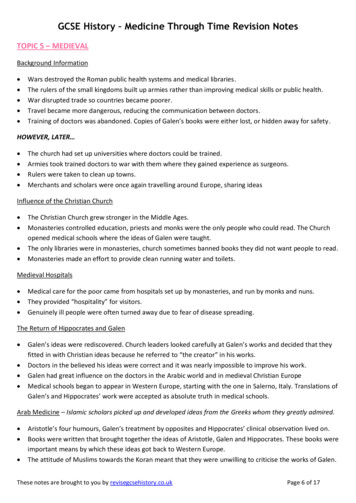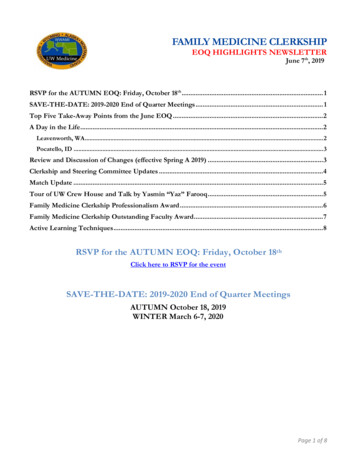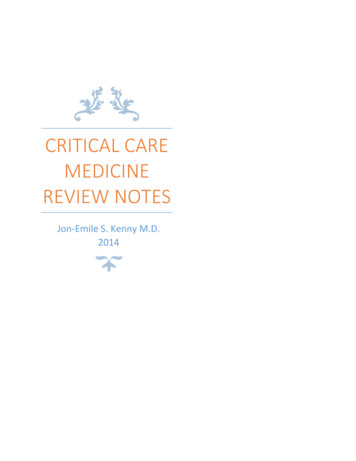
Transcription
CRITICAL CAREMEDICINEREVIEW NOTESJon-Emile S. Kenny M.D.2014
Critical Care Board Study Notes 2014hEsteemed reader,I compiled these notes while studying for the ABIM Critical CareMedicine Board examination. These notes were made from anumber of fairly recent resources including SCCM lectures, SEEKquestions, ACCP study guides and, of course, pulmccm.org. Icannot guarantee their correctness in content, grammar, andspelling; nor are these notes peer-reviewed. They absolutelyshould not be used as a resource for patient care. They should beused for board exam preparation; that is all I will use them for aswell. This is not my heart-lung physiology text. Please share thesereview notes freely. #FOAMccHappy Studies,Jon-Emilewww.heart-lung.orgJEKCritical Care Medicine Review Notes1
Critical Care Board Study Notes tical Care Medicine Review Notes2
Critical Care Board Study Notes 2014h1. CRITICAL CARE CARDIOLOGYCARDIAC RESUSCITATIONaccount of the cold diuresis. There is anincreased risk of infection following TH andaltered drug metabolism.The quality of CPR is associated with survival todischarge for in-house arrest. It is not theapplication of an AED, which has been studied.40% of chest compressions in house are ofinsufficient depth, there is a long period of timeduring codes when health care providers are notactually on the chest. Compressions should behard and fast [to Bee Gee’s stay’n alive] 100 perminute, 2 inch depth. There should beminimization of time off the chest even for pulsechecks and defibrillation. It is CPR that matters, 2minutes of CPR interspersed with defibrillation, 1mg epinephrine every 3-5 minutes or 40 U ofvasopressin. Atropine is no longer a part of PEA.However, skeptics noted the lack of blinding totreatment allocation in the above studies.Further, in the biggest of those hypothermiastudies, a large number of patients in the usualcare group developed fever which is associatedwith worse outcomes after cardiac arrest. So itwas thought that perhaps TH simply had toaccomplish fever reduction to improve outcome.So the big one came out in NEJM November 17,2013 [950 patients in 3 years, 80% vfib, 12%asystole, 8% PEA, and randomized the patients tocelsius 33 or 36 ASAP for 28 hours and then feverreduction for 72 hours]. After 72 hours, aneurologist blinded to initial treatment allocationrecommended withdrawal or continued carebased on standardized criteria, with withdrawalrecommended only for known predictors of aterrible outcome [e.g., refractory statusepilepticus; Glasgow motor score 1-2 withbilateral absence of N20 peak on median nerveSSEP]. CPC more than 2 or Rankin more than 3was defined as severe disability. There was nodifference in death or disability between the twogroups [i.e. 33 versus 36 degrees] even in the 80%shockable group.Avoid hyperventilation as this can reducecerebral perfusion via alkalemia and moreimportantly cause dynamic hyperinflation.Previously, the brain injury [apoptosis,excitability, edema, etc.] induced by ischemia reperfusion was thought to be treatable. The Feb.2002 NEJM article with 137 patients in each arm,enrolled witnessed, shockable cardiac arrestpatient s with ROSC but still not followingcommands. Patients were randomized totherapeutic hypothermia target 32 to 34 celsiusover 8 hours, held at that temp for 24 hours andthen passively re-warmed over 8 hours. A metaanalysis of the three largest trials [380 patients]showed an odds ratio of 1.7 for favourableneurological outcome. The largest of the threetrials selected patients who were resuscitatedwithin 60 minutes with a shockable rhythm,comatose, and not in shock. Cooling was donewithin 2 hours of the event.Temperature should be maintained at 36 C orbelow after out-of-hospital cardiac arrest.Despite its physiologic rationale and evidence ofbenefit in prior smaller studies, targetedtemperature management below 36 probablydoes not improve outcomes after out-of-hospitalcardiac arrest of any type. Because averagehuman core temperature is 37 C, maintainingtemperature continuously at or below 36 C stillwould require cooling in almost all patients.Therapeutic hypothermia [TH] is commonlyassociated with coagulopathy, hyperglycemia,bradycardia and hypovolemia – the latter onwww.heart-lung.orgJEKCritical Care Medicine Review Notes3
Critical Care Board Study Notes 2014hIn a related vein, in 2013 JAMA, 100 patients withbacterial meningitis were randomized to 32-34degrees or standard care and this trial wasstopped early for a 20% absolute risk increase inmortality!prior to the arrest was a major discriminator inoutcome:Only 10% of patients on pressors prior to arrestsurvived to discharge, and only 4% overall weredischarged home [the others went to rehab orlong-term acute care].What about the prognosis following cardiacarrest? What is the false positive rate fordiagnosis of poor neurological outcome? Weshould strive for zero. Pupillary reaction to lighthas a false positive rate of 0-31% at day one. Atday three, no pupillary reaction has a falsepositive rate for poor outcome of zero. So absentpupillary response at day three is importantinformation. The absence of corneal reflex issimilar at 72 hours. What about posturing?Similar at 72 hours. All of this data wasgenerated during an era of no therapeutichypothermia and the reason why neurologicalassessment for continued care in theaforementioned trial took place at 72 hours.Among those with PEA/asystole despite pressors,only 1.7% were able to perform their ownactivities of daily living at the time of discharge.People with ventricular fibrillation or tachycardianot requiring pressors prior to arrest did muchbetter: 40% survived, 20% went home, and17% had good neuro outcomes.CONGESTIVE HEART FAILUREAbout 50% of the mortality with heart failure issudden, the other half is slow progression. Thereare stages of heart failure described in 2001[ACC/AHA] where stage A is those patients atrisk, B [structural disease without symptoms] isNYHA I, stage C [current or prior symptoms]corresponds to NYHA II and III and stage D isNYHA IV.So what has a perfect specificity for determiningpoor neurological outcome? There is a review inthe Lancet – day 3 absent motor, absent pupillaryresponse and abnormalities in somatosensoryevoked potentials. SSEP occurs when the mediannerve is stimulated. Bilateral absence is poorneurological prognosis from NEJM article in 2009.Day 1-3 there is nothing great to help. You mustwait at least 72 hours and you must wait foranalgesia to wear off. This is important with THbecause there is alteration of sedation andanalgesia metabolism with hypothermia – it willstay longer. There is no clear answer as to whenthe patient may wake up, but anecdotally up toone week as the effects of hypothermia wear offand sedation is cleared, though this will be lessimportant as TH is used less with the results ofthe Nov. 2013 NEJM trial.NYHA Class IV heart failure has a 60% mortality atone year. In acute, severe heart failure a poorprognosticator is: hypotension. Hypernatremiaand polycythemia are not. Hypotension isdefined as a systolic below 115 mmHg. Otherbad prognoses: hyponatremia, CAD, high BUN orcreatinine, low EF, elevated BNP or troponin,anemia, diabetes.Precipitants of ADHF? 25% excess salt and fluidintake, 25% noncompliance with medications,and 16% from adverse medication effects [e.g.new CCB, NSAID, steroids, glitazones and ethanol,new anti-arrhythmics]. The rest are acutemedical causes such as ischemia, PE, HTN, valvedysfunction, arrhythmia. There are extra-cardiaccauses as well – sepsis, infection, renal failure,thyroid, new anemia.Prognosis after a first cardiac arrest occurring inthe ICU is poor. An observational study of almost50,000 such arrests showed an overall survival tohospital discharge of 16%. Requiring vasopressorswww.heart-lung.orgJEKCritical Care Medicine Review Notes4
Critical Care Board Study Notes 2014hFLAVORS OF MYOCARDIAL DYSFUNCTIONexercise tolerance, cardiac performance andmaybe survival.There are different kinds of myocardialdysfunction to consider – hibernating, stunnedmyocardium, sepsis, myocarditis, etc. Stunnedmyocardium occurs when there is ischemia thatrelates to a wall motion abnormality, but whenblood flow resumes, there is a persistent WMAthat lasts from hours to days. The patient mustbe supported during these time – consider stresscardiomyopathy as an example of stunnedmyocardium. The patient may present with allthe signs and symptoms of ischemia and heartfailure with stress cardiomyopathy. There mustbe no coronary stenosis to explain the diseaseand WMA do not correspond to single coronarydistribution. There may be STE and big T waveinversions.With myocarditis, patients typically get betterthemselves, not good data but prednisone likelyimproves EF by 5% but only if there is cellularinfiltrate on biopsy. There is improved exercisetolerance and cardiac performance.TREATMENT MODALITIES FOR HEART FAILURETreatment should improve quality & quantity oflife; some meds do one or the other or both.What about diuretics? There is no difference incontinuous infusion versus bolus - Felker et al inNEJM 2011 [DOSE trial]. However high doseseemed to improve global assessment ofsymptoms – high dose is double their outpatientdose. There was no difference in creatinine,readmission, no cardiac performance change,there is no survival benefit shown.Recognize Takotsubo cardiomyopathy – themajor complications of this are mechanical innature, heart failure, shock and arrhythmia. Itpresents exactly like a STEMI, or at least it can,but angiogram is normal and there is apicalhypokinesis on the LV gram, this invariablyresolves by 2 months. Some argue against theuse of inotropes or catecholamines in thesepatients as they catechols be the cause; theyargue that IABPs should be used. This diseaseusually happens in post-menopausal women andhas a mortality rate of 0-8% in house.What about vasodilators? V-HEFT trial wasoriginal hydralazine with isosorbide versusprazosin versus placebo. The hydral-nitrategroup had a mortality benefit.Nesiritide is a formulation of BNP which wasinitially derived from pig brain. It antagonizes therenin-angiotensin axis and comes from theventricles of the heart – it is released in responseto high ventricular volume and pressure. Itcauses diuresis & vasodilation. It causes a drop infilling pressure, blood pressure and increasescardiac output. It lowers filling pressurecompared to nitroglycerine and diuretics. Butnesiritide doesn’t significantly improve clinicalend-points in O’connor et al. NEJM 2011 – itmight improve dyspnea. There is no effect ondeath [does not increase mortality] and rehospitalization.Hibernating myocardium is due to chronicischemia without infarction. There will be a WMAthat lowers ejection fraction. If the occlusion isreversed, the ejection fraction will return tonormal. What kind of revascularization? In theCAST trial, those with a low ejection fraction whogot CABG did better. The STITCH April 2011NEJM looked at chronic heart failure patients [EFless than 35%] with bypass surgery [versusmedical therapy] and there was improved deathfrom cardiac causes, hospitalization [not overalldeath] with CABG. Based on CAST and STITCH,improving hibernating myocardium byrevascularization can improve NYHA class,www.heart-lung.orgACE inhibitors do everything! Consensus in NEJM1987 was quite impressive in terms of mortalitybenefit for severe, symptomatic systolic heartfailure. Angiotensin II blockers are likely as good.JEKCritical Care Medicine Review Notes5
Critical Care Board Study Notes 2014hThe addition of ARB to ACEI may improve in somepatients [CHARM trial].electromechanical association. The COMPANIONtrial in NEJM showed that CRT in patients withNYHA III-IV HF with an EF of less than 35% and awide QRS improved a combined end-point ofmortality and hospitalization compared tostandard care. All-cause mortality by itself wasonly lowered in the CRT plus AICD group. CRTdoes not increase myocardial oxygen demandand is associated with reverse remodeling of themyocardium with an improved LVEF. CRT also:improves stroke volume, dyspnea [functionalclass], mitral regurgitation, and lowers Ppao.NEJM - RALES in 1999 improved mortality insevere heart failure with spironolactone, butoverall few of the patients in RALES were onchronic beta-blockers as it was not an entirelyaccepted therapy at the time of enrollment forthat trial. Juurlink NEJM -2004 ICES databasereview showed excess hyperkalemiahospitalization and deaths after RALES.Eplerinone [less gynecomastia] can reducemortality following MI with LV dysfunction, insystolic heart failure with mild symptomsEMPHESIS-HF also reduced mortality [NEJM2003], and there is an increase in potassium aswell. It improves cardiac performance.How about VADs? Eric Rose et al. NEJM 2001[REMATCH trial] in late class IV heart failureshowed improved survival [ARR 25% in death]using pulsatile flow or pusher plate. Continuousflow VAD, however, is better per Slaugther 2009NEJM.What about inotropes? In the 1980s, patientswho had the highest norepinephrine levels didthe worst. Chronic use of inotropes – will worsenmortality – dose-dependent decrease in survival.They should only be used when nothing elseworks.Heart transplant? Hearts are limited resources.The one year survival is 85-90%, 10 year survivalis about 50% for heart transplant. Many get toNYHA I and II with transplant.Both US carvedilol [NEJM 1996] and the MERITHF [lancet 1999] trial showed survival benefitwith beta-blockers in low EF [carvedilol and XLmetoprolol, respectively] and Copernicus in 2001[very low EF patients getting carvedilol].The ESCAPE study looked at the use of pulmonaryartery catheters in heart failure, there is nomortality benefit, but perhaps betterhemodynamics.ST-ELEVATION MYOCARDIALINFARCTIONDigoxin reduces hospitalizations, reducessymptoms in the Digitalis investigation group [DIG- NEJM 1997].With STEMI, about 50% of people just drop dead,without crushing chest pain preceding the event.It is common for there to be minimal or nocoronary stenosis seen on an angiogram prior tothere being ACS. Yet, there is abnormal flow onangiography in more than 90% of patients withSTEMI [60% with TIMI zero or total occlusion, 13%with TIMI 1 or penetration but no distalperfusion, and 19% with TIMI 2 flow or completepenetration, but delayed perfusion].What about anti-arrhythmic therapy? The MUSTtrial NEJM 1999 showed benefit with defibrillator– addition of medical anti-arrhythmia worsensmortality [similar to afib trials RACE and AFFIRM].SCD-HEFT showed that amiodarone does notincrease mortality compared to placebo, but ICDimproves survival for sure – especially those withLVEF less than 35% [also MADDIT 1 &2 trials].If there is LBBB and QRS more than 120 ms, anddepressed LVEF with symptoms, the patient canbegin CRT therapy – BiV pacing to try to improvewww.heart-lung.orgWhat are the clinical events associated withplaque rupture? Clearly many, but documented:JEKCritical Care Medicine Review Notes6
Critical Care Board Study Notes 2014hshoveling snow, earthquakes, bad traffic,watching stressful sporting events [e.g. the Leafsor the Canucks], respiratory tract infections,waking up in the morning. There is evidence tosuggest that the influenza vaccine reduces MIrisk! So vaccinate patients with coronary disease.the cath lab emergently. The LBBB is known toobscure the normal patterns of ischemia on theECG and LBBB patients tend to have a worseprognosis during coronary ischemia, so there ismore to be gained by revascularization.Wenkebach is not a classic finding in coronaryischemia, but rather pathological changes in theAV node [though it can accompany right coronaryischemia, this should also present with STchanges in the inferior leads]. Complete heartblock is less commonly a result of coronaryischemia. Long runs of Vtach will certainlyobscure STEMI, but if the runs are short, then theinterceding ECG should still detect current ofinjury.ECG AND STEMIThere may be profound, dynamic ECG changes ina matter of minutes – from t wave inversions toSTE. With confirmed MI [NSTEMI or STEMI], upto one third did not have chest pain. When thereis no chest pain, patients are treated differentlyand this may triple their mortality.A 12 lead ECG must be performed immediately inthe ED that is within 10 mins, this is class IBbecause the artery must be open within 90 mins.[STREAM – NEJM 2013 showed that a strategyinvolving early fibrinolysis with bonustenecteplase and contemporary anti-thrombotictherapy offers similar efficacy as primary PCI inpatients with STEMI who present within 3 hoursof symptom onset and who could not undergoprimary PCI within 1 hour of first medicalcontact].Recognize cerebral T waves on an ECG. Considera patient with a hypertensive internal capsulehemorrhage with an ECG with deep, inverted Twaves in the precordial leads. These are knownto occur following head bleeds, and sometimesischemic strokes. They are thought to be theresult of massive sympathetic discharge.Classically, Wellen’s sign is biphasic T waves inthe precordium, though it can presentsymmetrically.Note that left circumflex occlusion is commonlysilent on a 12 lead ECG [distal circumflex marginalartery]. This may lead to rupture of theanterolateral papillary muscle in days after theinfarction. The presence of a normal ECG withpulmonary edema should prompt evaluation forlateral coronary disease. If a PAC were placed,one would see tall V-waves. Importantly, on theddx of tall v waves is ventricular septal rupture,but this would give a 5 mmHg step up of oxygensaturation on the PAC [see below].If the first ECG is non-diagnostic and suspicion ishigh, repeat ECG should be performed within 1530 minutes and this too is class IB evidence.STE has a differential diagnosis; LVH, hyperK ,Brugada syndrome can all present with STE. Qwaves are present within 6 hours in about 50% ofSTEMI patients, and this is a poor prognosis. 29%of trans-mural MIs did not have Q wave, 28% ofsub-endocardial MIs [non-transmural] MIs didhave Q waves, so it is neither sensitive nor specificfor trans-murality [based on MRI study in 2004],but the probability of Q waves does increase asthe MI size and number of trans-mural segmentsincreased.TREATMENT MODALITIES FOR STEMIThree doses of SL NTG of 0.4 mg may be givenevery 5 minutes for a total of 3 doses after whichIV NTG should be considered.Recognize that characteristic symptoms forcoronary occlusion plus a new LBBB patternmeans that a patient should receive lytics or go towww.heart-lung.orgJEKCritical Care Medicine Review Notes7
Critical Care Board Study Notes 2014hIn the patient with STEMI, there should be dualanti-platelet therapy and heparin begun. Ifthrombolysis is given, standard of care is not togive GPIIBIIIA. For STEMI, morphine is still IC foranalgesia, all NSAIDs should be stopped atpresentation IC. IIIC evidence says that NSAIDsshould not even be started during hospitalization.the number of leads with elevation and thebenefit of fibrinolytic, in fact, and there is littlebenefit if only 2-3 leads have STE, but it is stillrecommended.What about GPIIBIIIA in STEMI? It is a 2Brecommendation, the benefit is uncertain basedon 2009 guidelines. It is reasonable to start thesedrugs at the time of PCI, so this is really the call ofthe interventionalist. Abciximab is a long-actingGPIIbIIIA inhibitor, so it should never be givenprior to potential bypass surgery. Abiciximab isnot cleared by the kidneys, but eptifibitide andtirofiban are.ISIS-2 trial 160 mg of ASA had a 23% reduction inmortality. In patients with STEMI, clopidogreldoes reduce mortality regardless of whetherreperfusion is received – it should be continuedfor 14 days. Unless there is CABG planned, thenclopidogrel should be stopped 5 days prior to OR.Anticoagulation should be used for at least 48hours, but up to 8 days even with reperfusiontherapy. The guidelines favor LMWH comparedto UFH. In STEMI, for every 100 patients treatedwith LMWH there are 15 less non-fatal MI, 7 lessurgent revascularizations, 6 fewer deaths but 4more non-fatal bleeds [no increase in ICH].The mortality benefit of primary PCI comparedwith onsite fibrinolysis was nullified when thetime delay to primary PCI was more than 2 hours.Fibrinolytic therapy in STEMI should be infusedwhen an anticipated delay to performing primaryPCI is more than 120 minutes of first medicalcontact [FMC]; FMC defined as the time at whichthe EMS provider arrives to the patient.Pooled analysis of ECG and fibrinolytic therapyshowed that per 1000 patients, 49 lives weresaved if baseline ECG showed LBBB, 37 saved withanterior STE, 8 saved if inferior STE and 14harmed/died if ST depression on baseline ECG.Indication for fibrinolysis is symptoms within 12to 24 hours and STE in 2 contiguous leads or newor presumed new LBBB. Prior ICH, knowncerebral vascular lesions, ischemic stroke within 3months, suspected aortic dissection, activebleeding excluding menses, significant head orfacial trauma or neurosurgery within 3 monthsare the absolute contraindications to fibrinolysis.The relative contraindications are: systolic morethan 180, diastolic 110, prolonged [10 minutes]CPR, major surgery [including eye surgery] orinternal bleeding such as GI/GU bleed within onemonth, non-compressible vascular punctures[e.g. recent trans-venous pacemaker insubclavian vein], pregnancy, and current use ofanti-coagulants. If you can’t re-perfuse an arterywithin 90 minutes with STEMI, you should give afibrinolytic, there is a direct correlation betweenwww.heart-lung.orgIf someone gets fibrinolysis, what is the benefitfor rescue PCI? This is the TRANSFER-AMI trialand there seems to be clinical benefit for transferimmediately to cath lab following lysis [up to 6hours post lysis]. Those going to a non-PCI facilityshould receive lysis or immediate transfer for PCI,the decision depends upon the mortality risk,lysis risk, duration of symptoms on presentation,time required for transport. Those patients bestsuited for transfer are: more than 4 hours aftersymptoms, high risk lesions or features [e.g.shock, see below], high bleeding risk. Forpatients going for PCI, AC should be initiated, donot use fondaparenux as it can cause catheterclotting.Know the SHOCK trial [NEJM 1999]. In patientspresenting with STEMI and cardiogenic shock,emergent revascularization [either PCI oremergent CABG] provided a mortality benefitcompared to thrombolysis. Of those who didsurvive, the vast majority [more than 80%] wereJEKCritical Care Medicine Review Notes8
Critical Care Board Study Notes 2014hNYHA 1 or 2 at one year. The minority of patientsin the SHOCK trial presented with hypotension tothe hospital, but go on to do so within 24 hours.Further, 25% of patients from the SHOCK registrylacked pulmonary congestion on examination[recall, all of these patients were in cardiogenicshock].depressed RV function on TTE. RV infarction isseen in 30% of patients with inferior MI and isclinically significant in about 10% of those withinferior MI.The treatment is maintaining RV preload,inotropic support, reperfusion. Diuretics shouldnot be used. IABP is an effective option in RVinfarction. Sometimes pacing to maintain AVsynchrony is needed, cardioversion for SVTs.No trials support the use of IABP in acutemyocardial infarction with shock [in fact, theIABP-SHOCK2 trial in NEJM 2012 refutes itsvalue], though it is often done. In the originalSHOCK trial, the patient’s in the medical armcould not be re-vascularized until 54 hours afterthe event. The 30 day mortality was no differentbetween the two arms [47 versus 56% mortality]!However, the 6 month mortality was significant[50 versus 63%]! While there was mortality nonsignificant mortality reduction at 30 days, inpatients under 75 years, it was significant at 30days.Reperfusion typically results in RV improvementin days. Nitroglycerin should not be given tohypotensive patients, or suspected RV infarction,nor patients who have received PDEI in 24-48hours. With administration of lytics, the bloodpressure remains low, but the heart rateincreases. Volume infusion should be consideredto improve preload. Streptokinase itself cancause some hypotension, but this is much lesslikely with tPA.MECHANICAL COMPLICATIONS OF STEMIBased on the SHOCK trial, cardiogenic shock is anAHA class I indication for emergentrevascularization. Nitrates, beta-blockers and aceinhibitors are generally avoided in cardiogenicshock because they can exacerbate hypotension.Recognize mechanical complications postinfarction. Pra, RV diastolic, PA diastolic andpulmonary artery occlusion pressure [Ppao] allelevate and are within 5 mmHg of each otherwith tamponade secondary to cardiac rupture.Post-infarction rupture is different fromhemorrhagic pericarditis, which may occur in thesetting of thrombolysis. Hemorrhagic pericarditisis not the result of a ruptured muscular wall. Itcan be treated with needle decompression, butthis often clogs, and sometimes a surgicalwindow is required.Oral BB should be started in the first 24 hours,unless there are concern for shock, pulmonaryedema, elderly, more than 12 hours ofsymptoms, bradycardia or heart block, reactiveairway disease. ACEI should be started if LVEFless than 40% or with DM, CKD, HTN.RIGHT VENTRICULAR INFARCTIONHypotension with acute inferior MI shouldprompt right sided precordial leads. RV infarctionmay show shock with clear lungs, elevatedvenous pressures, Kussmauls sign, and ‘squareroot sign’ on PAC [see below].The most difficult ddx in the setting of equalizedcardiac pressures is that of an RV infarctionsecondary to right coronary occlusion which canalso raise Pra, Prv, and Ppao [via ventricularinterdependence] but in the setting of a knownLAD lesion, rupture would be more likely.Look for tall R waves in the anterior pre-cordialleads. The patient will present with hypotension,bradycardia and an absence of pulmonarycongestion. There will be STE in right sided leads,www.heart-lung.orgOther considerations are: VSD which woulddisplay an oxygen step up of 5 mmHg from the RAto the RV.JEKCritical Care Medicine Review Notes9
10Critical Care Board Study Notes 2014hAnother option would be papillary musclerupture of the posterolateral leaflet, but thiswould be presented with a murmur, crackles andtall V waves. Consider this in a patient 48 hourspost inferior MI with sudden onset, bilateralpulmonary edema with low output. There maybe no audible murmur. An inferior infarction cancause rupture or the posterolateral papillarymuscle as it has a single blood supply and issusceptible to ischemia the most. The murmur isoften absent because of equalization ofpressures.immediately. For ASA, the dose doesn’t seem tomatter, but less is more in terms of bleeding.Plavix reduces the risk of composite end point by2.1% in the CURE trial – NEJM 2001. Whether ornot patients will not receive a cath, Plavix shouldbe started ASAP [600 mg per CURRENT OASIS 7 –NEJM]. Recall that some PPIs are metabolized byCYP2C19, omeprazole and Plavix moves throughthat CYP – the data about this is totally mixed. Itis probably OK to use clopidogrel and PPIsconcomitantly, but often patients don’t reallyneed the PPI.In each of the mechanical complications of MI,the mortality is very high. Surgical mortality isabout 50% for VSD [worse with inferior ischemia]and papillary muscle rupture and there are casereports of surgical survival in patients with freewall rupture. Medical mortality approaches 90%in all forms.The choice of the second anti-platelet agent to beadded to ASA includes: as above, clopidogrealbefore or at time of PCI, an IV GPIIBIIIA before orat time of PCI, or prasugrel at the time of PCI.Fondaparinux should not be used if going to thecath lab because of catheter thrombosis.Anti-coagulation should be added ASAP withpresentation. When invasive strategy is chosen,the patient should get either LMWH, UFH orbivalirudin. In a patient with renal failure, or CrClless than 30 ml/min, fondaparinux is contraindicated, LMWH can be used, but it must bedose-adjusted. UFH may be used. The generaldose of UFH for ACS is a loading dose of 60 U/kgbolus and maintenance of 12/Kg/hr for PTT of 5070. Fondaparinux is 2.5 mg SQ once, but cannotbe used if CrCl is less than 30. It should not begiven if going to the cath lab. Bivalirudin is OKwith a history of HIT.NON-ST SEGMENT ELEVATIONMYOCARDIAL INFARCTIONIschemic chest pain may involve an occlusivethrombus or non-occlusive thrombus and theseclinical scenarios can be detected by the ECG asSTEMI and NSTEMI, respectively. Unstableangina is the term for ischemic chest painwithout ECG change and no biomarker elevation.Consider an NSTEMI patient on dialysis withrecent history of TIA/stroke – all of the followingare contraindicated: prasugrel, LMWH,eptifibitide and fibrinolysis. Recall that with STsegment depression there is harm with theadministration of fibrinolysis. There is anincreased risk of ICH absolute of 2.3% in thosewith a history of stroke or TIA. Too manypatients in the US on dialysis received the contraindicated medications: LMWH and eptifibitide –this increased the risk of death.What about CCB? There is old evidence from thelate 1980s, in patients with pulmonary edema byCXR or exam, diltiazem can worsen outcome.But, a CCB can be used over a BB if the patienthas a normal LVEF and is not in failure as a meansto minimize myocardial oxygen demand.An ACEI should be given within 24 hours inNSTEMI in patients with pulmonary congestion ordepressed LVEF unless there is hypotension orcontraindication to that class of medication.Patients with NSTEMI and a low EF should beWhat about anti-platelets? Those at medium tohigh risk and in whom an initial invasive strategyis chosen, the patient should receive ASAwww.heart-lung.orgJEKCritical Care Medicine Review Notes
Critical Care Board Study Notes 2014strongly considered for cardiac catheterization.Th
Medicine Board examination. These notes were made from a number of fairly recent resources including SCCM lectures, SEEK questions, ACCP study guides and, of course, pulmccm.org. I cannot guarantee t
